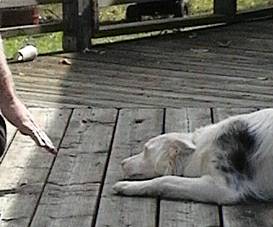 OBEDIENCE
OBEDIENCE DEAF DOWN
DEAF DOWN
 OBEDIENCE
OBEDIENCE DEAF DOWN
DEAF DOWN
Since no trainer seemed anxious to take on our deaf boy, we felt a few of the differences should be discussed. Each dog is an individual remember!
In basic obedience, we learned voice command, always.
Signals are for the more advanced. Patches is impressed! Duh!
 When working two dogs, it is easier for your deaf dog to be next to your leg.
When working two dogs, it is easier for your deaf dog to be next to your leg.
Here we are actually working on down/head down.
 *
* For deaf Patches, the signal should be exaggerated. Tory responds on the upward motion of your arm as he should, and at some point Patches will too, but the important thing is that he understands what you are communicating. A clear, deliberate signal.
For deaf Patches, the signal should be exaggerated. Tory responds on the upward motion of your arm as he should, and at some point Patches will too, but the important thing is that he understands what you are communicating. A clear, deliberate signal.

Don't be afraid to invent your own signals. Yes, there are traditional obedience signs, but your job with your deaf dog is to make each sign distinctive, and for me, that takes a little imagination. But, if you intend to trick train, a lot of those distinguishable signs will be required.
Basic obedience is taught on lead. The lead serves as a training tool.
 *
*
But, when they tell you Not to work your dog off lead! nonesense,
lessons can be part of 'just having fun'.
Patches is ball crazy.. ..so, we use that.
..so, we use that.
Three or four times during a play period, we signal down, before we toss the tennis ball. It even adds to the anticipation. Tory is not exempt. His game is frisbee. Occassionally, a down will be signalled after a catch, during the retrieve. We haven't started Patches 'downing' during a retieve,YET.

But, down is definately a part of his trick training.
REMEMBER a dog will do practically anything for a treat.
Use them lavishly at FIRST, then taper off as the trick is mastered.
Half of a puppy biscuit for a down, becomes half of a puppy
biscuit for a
down/head down, and so on. Down on it's own is now expected.
The treats become less, the tricks become more.